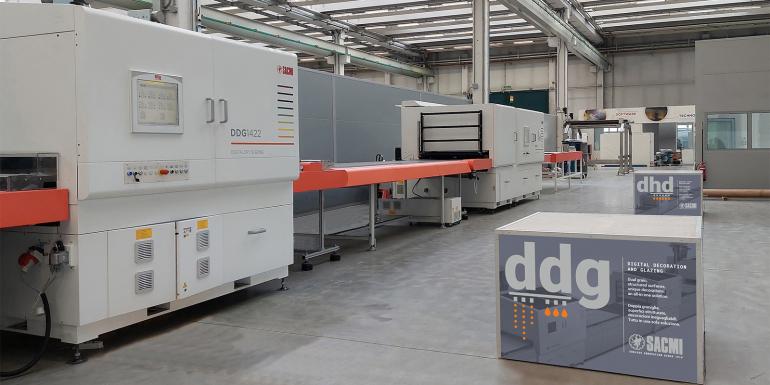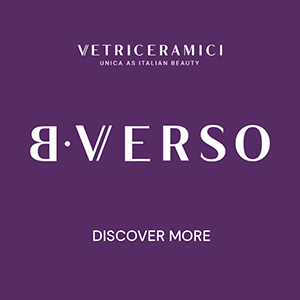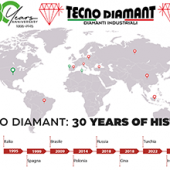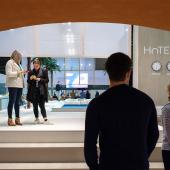Sacmi Digital Decoration LAB, a new ‘open platform’ for digital decoration research
R&D-dedicated area doubled and new staff hired. The goal: to establish an open facility for the businesses and universities of the Region Emilia-Romagna, with applications spanning from ceramic to metal and beyond.

A Sacmi priority for many years, digital surface decoration has seen its potential skyrocket thanks to the development of all-new technologies and application solutions.
That potential now extends beyond ceramics to other sectors, such as metal products and packaging.
And the new Sacmi Digital Decoration LAB aims to seize every opportunity. The Lab is co-funded by the ‘Local competitiveness infrastructure development support’ regional tender. By expanding its equipment pool and skills set, it aims to establish a well organized engineering and applied research facility for the digital surface decoration field.
The project was launched in January 2021. Its first goal was to create a true ‘industry hub’ at the Casalgrande (Reggio Emilia) facility, a place where both client companies and raw material suppliers (pigments, inks, materials) can test materials on pilot lines.
There are two main ‘families’ of solutions. These are housed in an area that will also include a ‘showroom’ displaying the most recent solutions. The first one, the Sacmi Deep Digital line, is the gold standard in digital ceramic decoration as it can perform both wet decoration and provide an array of new grit, spray-dried glaze, material and effect applications.
The second ‘family’ in the showroom is the DMD (digital metal decoration) line. This is used to decorate the pre-cut sheets used in metal packaging, an area of keen interest to both Sacmi and the wider ‘packaging valley’ region. In the latter, in fact, traditional offset decorations could be used alongside new digital decoration techniques, which are vastly more versatile when it comes to handling small batches and diversified product mixes.
Behind the showroom and pilot line, the Lab also has a prototype development and experimentation area. Again featuring upgraded equipment, this area has strengthened Sacmi's strategic ‘waveform’ research project (i.e. optimization of the electrical signals needed for proper droplet formation).
Waveforms play a crucial role in digital printing technology, on both the wet and dry application fronts. Optimization of this hitherto unexplored technological field will see the latest dry digital printers on the DDG line benefit from significantly improved quality.
Moreover, the analysis laboratory has been given an instrumentation upgrade to extend research into new fields and improve customer service.

In addition to expanding both the potential and the application range of digital printing, the project also focuses on research, development and characterization of new, sustainable materials. A good example of this is the use of ‘water-based’ inks-fluids with a low organic substance content.
This involves numerous players: on the one hand, the entire upstream part of the supply chain, such as ink and print head producers and, on the other, all potential downstream users such as ceramic manufacturers located at the center of the Italian ‘ceramic district’ between the provinces of Modena and Reggio Emilia.
Sacmi Digital Decoration LAB therefore acts as a link between businesses, suppliers and potential customers. Yet it also works in close collaboration with universities and the regional research center networkto speed up the transfer of innovation to businesses. These include the University of Modena and Reggio Emilia, other regional universities and Emilia-Romagna High Technology Network nodes/hubs with whom projects and partnerships in various fields are already under way.
Thanks to region-level co-funding, Sacmi has also recruited new specialists (Materials Engineers, Electronic Engineers, Chemists) to lay out development guidelines and bolster the existing lab team.
Indeed, development of human resources will be one of the project’s cornerstones. For internal personnel, this will be pursued by transferring skills between young graduates/trainees and research/production personnel within the Group’s various businesses. Know-how exchange will also take place between all the former and universities (via internships and dissertation projects). The Lab also aims to provide customers with advanced, ongoing training in order to align suppliers’ technical skills with the standards required by the new systems.
Started up last December, the Lab will become fully operational over the coming weeks as the infrastructure undergoes completion.
Did you find this article useful?
Join the CWW community to receive the most important news from the global ceramic industry every two weeks






















